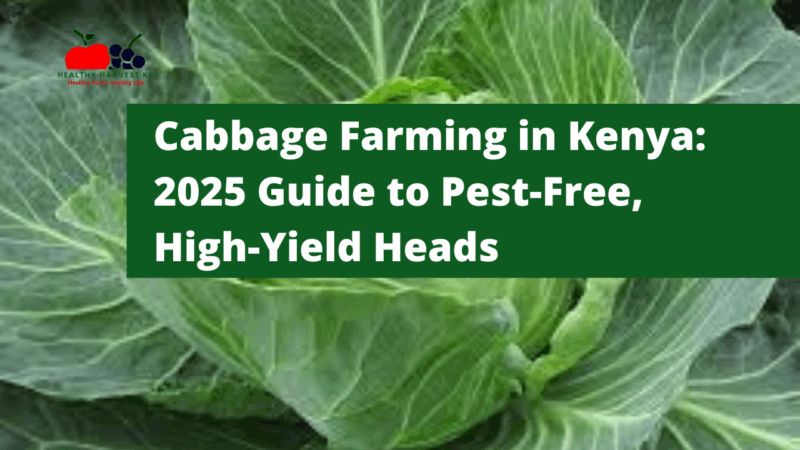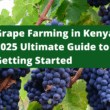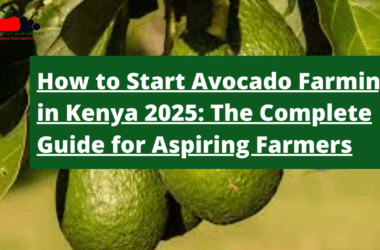Why Cabbage Farming in Kenya Makes Sense
Looking to start farming but not sure what crop to grow? Cabbage farming in Kenya might be your ticket to agricultural success. With annual production reaching about 600,000 tons and yields between 25-40 tons per acre, cabbage has become one of Kenya’s most profitable vegetable crops.
What makes cabbage particularly attractive is its quick turnaround—you can harvest in just 3-4 months—and the consistent demand both locally and in neighboring countries. With retail prices ranging from Ksh 15-50 per head, you could pocket up to Ksh 300,000 per acre after harvest.
Cabbage thrives in Kenya’s highlands (Central Kenya, parts of Rift Valley, and Western Kenya) where cooler temperatures and rich, well-drained soils create the perfect growing environment. For new farmers, cabbage offers an accessible entry point into commercial farming with relatively low production costs compared to many other crops.
Getting Started: Soil and Climate Requirements
Before you plant your first cabbage seedling, understanding the right growing conditions is crucial.
The Perfect Growing Environment
Cabbages love cool temperatures between 15-20°C, typically found at altitudes of 800-2500 meters above sea level. This makes regions like Central Kenya, parts of the Rift Valley, and western provinces ideal for cabbage production.
Your soil quality will significantly impact your harvest. Cabbages thrive in:
- Loamy soil that’s well-drained
- Soil rich in organic material
- Slightly acidic pH (6.0-6.8)
Before planting, get a soil test to determine pH levels and nutrient content. This small investment can save you from disappointing yields later.
Sunlight and Water Needs
Cabbages need 6-8 hours of direct sunlight daily, but too much heat can cause premature flowering (bolting). Find a balance—good sun exposure without excessive heat.
Water management is equally important. Cabbages need consistent moisture throughout their growth cycle, so ensure your field has reliable water access. Modern solutions like drip irrigation can boost yields by up to 30% by delivering water directly to the root zone while minimizing leaf wetness that could lead to disease.
Choosing Your Cabbage Variety
Selecting the right cabbage variety can make or break your farming venture. Several varieties perform well in Kenya’s diverse growing conditions:
| Variety | Key Features | Best For |
|---|---|---|
| Gloria F1 | Uniform heads, excellent transportation durability | Farmers targeting distant markets |
| Blue Jays F1 | Early maturity, good disease tolerance | Quick returns on investment |
| Pretoria F1 | Large, compact heads with high yields | Maximum production |
| Pruktor F1 | Excellent resistance to black rot and downy mildew | Reducing chemical interventions |
Consider factors like your farm’s altitude, typical rainfall patterns, expected maturity period, and disease resistance needs when making your selection. While hybrid varieties generally offer better yields and disease resistance, they require higher initial investment in seeds.
Land Preparation and Planting
Proper land preparation creates the foundation for healthy cabbage growth. Start this process 4-6 weeks before transplanting.
Preparing Your Soil
- Begin with deep plowing to break up compacted soil layers and improve root penetration
- Follow with harrowing about two weeks before transplanting to create fine soil suitable for seedlings
- Incorporate well-decomposed manure (about 10,000kg per acre) to improve soil structure and nutrient availability
- Consider creating raised beds (1 meter width) if you’re farming on slopes or in areas with poor drainage
Nursery Management
Most cabbage production starts with seedlings rather than direct seeding. To establish a productive nursery:
- Mix topsoil with well-decomposed manure (1:1 ratio) to create nutrient-rich growing medium
- Sow seeds in rows 10-15cm apart and lightly cover with soil
- Protect seedlings with mulch to retain moisture
- Water regularly and provide shade during intense sunlight
- Begin hardening off seedlings one week before transplanting by gradually reducing water frequency
Transplanting Tips
When seedlings develop 4-6 true leaves (typically 3-4 weeks after sowing), they’re ready for transplanting. For best results:
- Transplant during early morning or late afternoon to minimize heat stress
- Space plants appropriately:
- Large-headed varieties: 60cm × 60cm
- Medium-headed varieties: 45cm × 60cm
- Apply starter fertilizer like DAP (Di-Ammonium Phosphate) or NPK (23:23:0) at about 80kg per acre
- Water immediately after transplanting to ensure good soil contact
With proper spacing, you can fit approximately 14,500 plants per acre.
Effective Crop Management
Once your cabbage seedlings are in the ground, consistent management determines your success. Focus on three key areas: water, nutrients, and pest control.
Irrigation Strategies
Consistent moisture is essential, particularly during head formation. Depending on weather and soil type, you’ll likely need to irrigate every 3-5 days during dry periods.
If possible, implement a drip irrigation system. It delivers water directly to roots, improves efficiency by up to 30%, and keeps leaves dry to minimize disease risk. If drip irrigation isn’t feasible, use furrow irrigation or watering cans, applying water early morning or late evening to reduce evaporation.
Watch for signs of water stress like wilting and bluish-green leaf coloration. At the same time, avoid overwatering, which can cause heads to split and increase disease susceptibility.
Fertilization Approach
Cabbages are heavy feeders that need balanced nutrition throughout their growth cycle. Beyond your initial applications of manure and starter fertilizer:
- When plants reach 4-6 weeks after transplanting, top-dress with Calcium Ammonium Nitrate (CAN) at 50-80kg per acre (conventional farming)
- If farming organically, apply composted manure, bone meal, or approved organic fertilizers as side dressing every 2-3 weeks
Watch for signs of nutrient deficiencies:
- Purpling leaves? You might have phosphorus deficiency.
- Yellowish older leaves? Likely nitrogen shortage.
Foliar applications of balanced micronutrients can quickly address these issues when caught early.
Winning the Pest and Disease Battle
No aspect of cabbage farming requires more vigilance than pest and disease management. Common threats include aphids, diamondback moths, cabbage loopers, cutworms, black rot, clubroot, and downy mildew.
Integrated Pest Management
Instead of relying solely on chemical controls, implement Integrated Pest Management (IPM):
- Cultural Controls:
- Practice crop rotation (avoid planting cabbages or related crops in the same field for at least three years)
- Maintain field hygiene by removing crop residues promptly after harvest
- Avoid planting new cabbage crops near old brassica fields
- Biological Controls:
- Introduce natural predators like ladybugs for aphid control
- Use Bacillus thuringiensis (Bt) products for caterpillar pests
- Apply neem-based products and pyrethrum extracts for organic production
- Chemical Controls:
- Use registered pesticides only when necessary
- Follow label instructions regarding application rates, timing, and pre-harvest intervals
- Rotate between different chemical classes to prevent pest resistance
Regular field monitoring allows for early detection and intervention before infestations reach damaging levels. Combining resistant varieties like Pruktor F1 with these approaches provides multiple layers of protection.
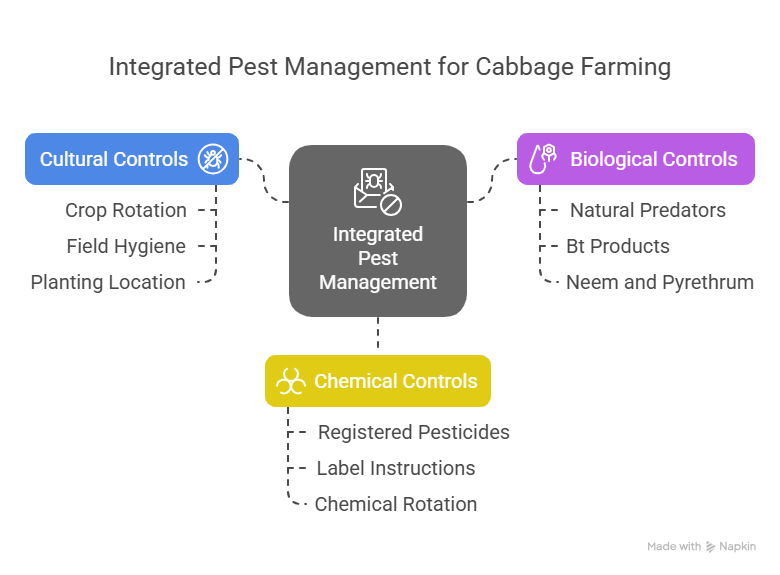
Harvesting Your Cabbage Crop
After 3-4 months of careful tending, your cabbages will reach maturity. Harvest readiness is indicated by firm, compact heads that feel solid when gently squeezed.
Harvesting Best Practices
- Harvest during cool morning hours to maintain freshness and extend shelf life
- Use a sharp knife to cut the stem just below the head
- Leave a few outer leaves attached for protection during transportation
- Handle carefully to prevent bruising and damage
For commercial operations, consider staggered planting to enable sequential harvesting. This ensures steady market supply and prevents flooding the market, which could drive down prices.
Post-Harvest Handling
How you handle cabbages after harvest directly impacts their market value:
- Remove damaged outer leaves
- Sort cabbage heads by size and quality
- Store in cool, shaded areas to maintain freshness
- Under optimal conditions (0-5°C with 90-95% humidity), cabbage can be stored for 3-6 weeks
Marketing Your Cabbage Crop
Having grown great cabbages, you now need to sell them profitably. Several effective marketing channels exist in Kenya:
Local Marketing Options
- Farmers’ markets: Sell directly to consumers without intermediaries, gaining higher profit margins and valuable customer feedback
- Local grocery stores and supermarkets: Build relationships for more consistent demand, though you’ll need to meet specific quality standards and delivery schedules
- Restaurants, hotels, and food vendors: Create stable demand channels, particularly if you can guarantee consistent supply and quality
- Social media and online marketplaces: Reach urban consumers directly, potentially adding delivery services for convenience
- Community Supported Agriculture (CSA): Build a subscriber base for regular produce deliveries, ensuring predictable income
Value Addition Opportunities
Consider pre-cutting and packaging cabbage for ready-to-cook convenience. This targets time-conscious urban consumers and often commands premium pricing compared to whole heads.
Financial Outlook for Cabbage Farming
Understanding the financial aspects of cabbage farming helps you make informed decisions about your investment.
Investment Requirements
For a one-acre cabbage farm, prepare for these startup costs:
- Land preparation (plowing and harrowing)
- High-quality seeds (hybrid varieties cost more but offer better returns)
- Manure and fertilizers
- Pesticides and fungicides
- Irrigation equipment
- Labor for planting and maintenance
Total production costs typically range from Ksh 60,000-100,000 per acre, including:
- Seeds: Ksh 3,000-8,000 for hybrid varieties
- Fertilizers: Ksh 15,000-25,000
- Pesticides: Ksh 8,000-15,000
- Labor: Ksh 20,000-30,000
- Transportation and packaging: Variable
Potential Returns
Under optimal conditions, expect yields of 25-40 tons per acre (approximately 30,000 cabbage heads). At retail prices of Ksh 15-50 per head, gross revenue potential can reach up to Ksh 300,000 per acre per harvest cycle.
With typical production costs between Ksh 60,000-100,000 and potential revenue of Ksh 300,000, profit margins can be substantial. The relatively quick growth cycle of 3-4 months means you can potentially achieve a return on investment within the first harvest.
Overcoming Common Challenges
Like any farming venture, cabbage farming comes with challenges. Here’s how to overcome the most common ones:
Weather Variability
Kenya’s changing climate patterns create unpredictable rainfall, prolonged droughts, and temperature fluctuations. Combat these by:
- Using shade nets in hotter regions to moderate temperatures
- Implementing water harvesting techniques and efficient irrigation
- Building raised beds to improve drainage during heavy rainfall
- Adjusting planting seasons based on climate forecasts
- Experimenting with heat-tolerant varieties in warming regions
Market Fluctuations
Cabbage prices can fluctuate dramatically based on supply variations and seasonal factors. Protect yourself by:
- Implementing staggered planting schedules to spread harvests across different time periods
- Diversifying into multiple sales channels rather than relying on a single market
- Adding value through processing (like cabbage powder or fermented cabbage)
- Joining cooperative marketing groups to improve bargaining power and access larger markets
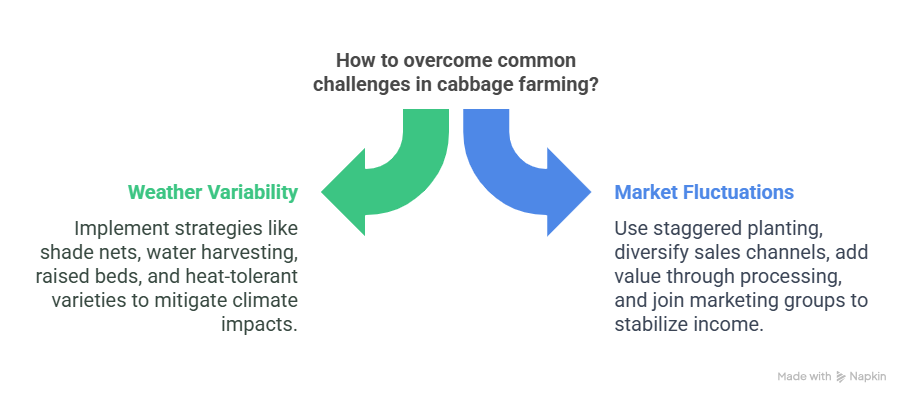
Best Practices for Long-Term Success
To ensure consistent quality, yields, and profitability in your cabbage farming venture:
Maintain Soil Health
- Test soil regularly to enable precise amendments
- Use cover crops during fallow periods to improve soil structure and prevent erosion
- Compost farm waste to create valuable organic matter
- Minimize soil disturbance through reduced tillage practices
Commit to Continuous Learning
- Participate in farmer field schools, agricultural exhibitions, and training programs
- Network with other successful cabbage farmers to share knowledge
- Embrace appropriate technologies like soil moisture sensors and digital record-keeping
- Document farm activities, costs, yields, and market prices to identify trends and optimize practices
Conclusion
Cabbage farming in Kenya offers an attractive opportunity for new farmers looking to establish profitable agricultural ventures. With relatively quick maturation, strong market demand, and substantial profit potential, cabbage provides faster returns than many other crops.
Success in cabbage farming requires attention to varietal selection, proper growing techniques, effective pest management, and strategic marketing. By implementing the practices outlined in this guide and continuously adapting to changing conditions, you can build a sustainable and profitable cabbage farming operation.
Remember that farming is both a science and an art—combine proven techniques with your own observations to develop practices that work best for your specific situation. Happy farming!
This guide draws upon resources from Farming in Kenya, Growpact Kenya, and Graduate Farmer.




